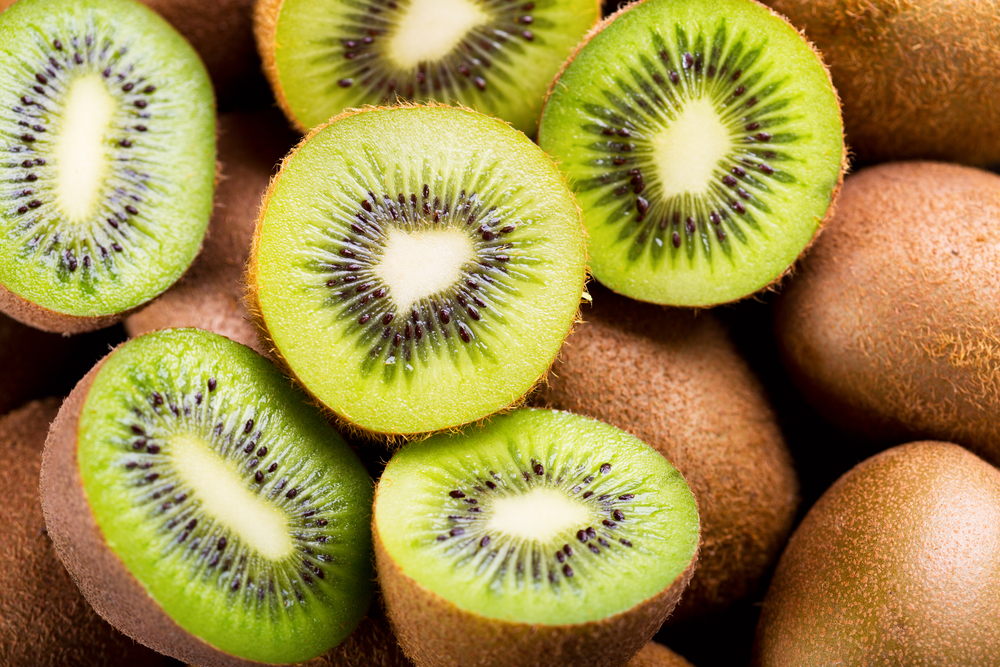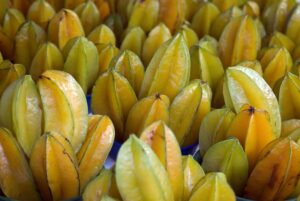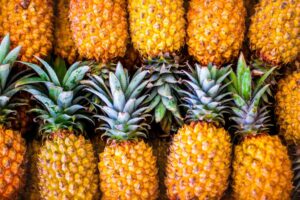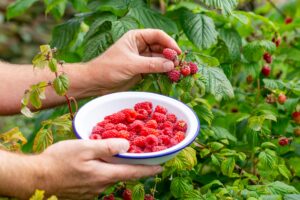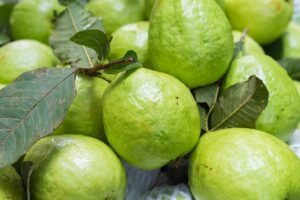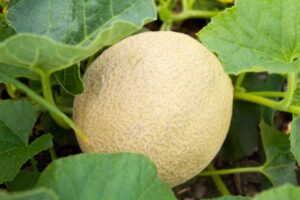How to Grow and Care for Kiwi: Complete Guide for Home Gardeners
Are you looking to add a unique, nutritious fruit to your garden? Kiwi plants (Actinidia spp.) offer not only delicious fruits packed with vitamin C but also attractive vines that can enhance your landscape. Whether you have a spacious garden, a sunny patio with room for containers, or even a small indoor space, you can successfully grow these sweet and tangy fruits with the right care. This comprehensive guide will walk you through everything you need to know about growing kiwi plants in various settings across the US.
Understanding Kiwi Plants
Before diving into cultivation practices, it’s essential to understand what kiwi plants are and which varieties might work best for your specific location.
Types of Kiwi for US Gardens
The US market offers several kiwi varieties, each with unique characteristics suitable for different growing zones:
- Fuzzy Kiwi (Actinidia deliciosa) – The common grocery store variety that requires a longer growing season (zones 7-9)
- Hardy Kiwi (Actinidia arguta) – Smaller, smooth-skinned fruits that can withstand temperatures down to -25°F (zones 4-9)
- Arctic Kiwi (Actinidia kolomikta) – The most cold-hardy variety, surviving temperatures as low as -40°F (zones 3-8)
- Purple Kiwi (Actinidia purpurea) – Features unique purple flesh and grows in zones 7-9
According to the USDA Agricultural Research Service, hardy kiwi varieties are becoming increasingly popular in the US due to their adaptability to various climate conditions.
Male and Female Plants
One crucial aspect of growing kiwi is understanding that most varieties are dioecious, meaning you’ll need both male and female plants for fruit production:
| Plant Characteristic | Male Kiwi Plants | Female Kiwi Plants |
|---|---|---|
| Flowering | Produce larger clusters of flowers | Produce fewer, larger flowers |
| Pollination Role | Provide pollen only | Produce fruit after pollination |
| Required Ratio | 1 male plant | Can pollinate up to 8 female plants |
| Identification | Dense clusters of stamens | Prominent sticky stigma in center |
| Fruit Production | No fruits produced | Produces fruits when pollinated |
| Growth Rate | Generally more vigorous | Typically less vigorous |
Growing Kiwi From Seed
While most commercial kiwi plants are propagated through cuttings, growing from seed can be a rewarding, if slower, process.

Step-by-Step Seed Starting Guide
- Obtain seeds: Extract seeds from ripe kiwi fruit, rinse thoroughly, and let dry on a paper towel for 1-2 days.
- Stratification: Place seeds in a damp paper towel in a sealed plastic bag and refrigerate for 4-6 weeks to simulate winter conditions.
- Planting:
- Fill seed trays with well-draining seed starting mix
- Place seeds on the surface and cover with a thin layer (1/8 inch) of soil
- Mist to moisten the soil without displacing seeds
- Cover trays with plastic to maintain humidity
- Germination environment:
- Maintain soil temperature between 65-75°F (18-24°C)
- Place in bright, indirect light
- Seeds typically germinate in 2-4 weeks
- Seedling care:
- Remove plastic cover once seedlings emerge
- Move to brighter light, but avoid direct afternoon sun
- Keep soil consistently moist but not waterlogged
- Transplant to individual 4-inch pots when they have 2-3 true leaves
- Hardening off: Gradually acclimate young plants to outdoor conditions over 7-10 days before transplanting.
Remember that kiwi plants grown from seed may take 5-7 years to bear fruit and won’t necessarily produce fruit identical to the parent plant.
Growing Kiwi in Garden Plots
For those with adequate garden space, growing kiwi vines in-ground provides the best long-term growing environment.
Site Selection and Preparation
Choosing the right location is critical for kiwi success:
- Sunlight: Select a spot receiving at least 6-8 hours of direct sunlight daily
- Wind protection: Provide shelter from strong winds that can damage tender growth
- Soil quality: Prepare well-draining soil with pH between 5.5-7.0
- Space considerations: Allow 10-15 feet between plants for standard varieties, 6-10 feet for hardy kiwi
Before planting, incorporate 2-3 inches of compost or well-rotted manure into the top 12 inches of soil to improve drainage and fertility.
Planting and Support Systems
Kiwi plants are vigorous climbers requiring substantial support:
- Support structure: Install a sturdy trellis, pergola, or arbor system before planting
- Planting depth: Dig holes slightly larger than the root ball, keeping the crown at the same level as in the nursery pot
- Spacing: Plant male and female vines 10-15 feet apart for standard kiwi, 6-10 feet for hardy varieties
- Initial care: Water thoroughly after planting and apply 2-3 inches of mulch around the base, keeping it away from the stem
According to the USDA Plant Hardiness Zone Map, determining your specific growing zone is essential for selecting appropriate kiwi varieties for your region.
Pruning and Training
Proper pruning is essential for fruit production and vine management:
- First year: Focus on establishing a strong central leader, removing competing shoots
- Second year: Develop a T-bar system with one main trunk and lateral cordons
- Mature plants: Prune in late winter to remove dead wood and maintain shape
- Summer pruning: Trim excessive vegetative growth to improve airflow and sun exposure
Growing Kiwi in Containers
Don’t have garden space? Container growing is an excellent option for kiwi, especially hardy and super-hardy varieties.
Container Selection and Setup
For successful container cultivation:
- Container size: Choose pots at least 15-20 gallons (24-30 inches wide, 18-24 inches deep)
- Material: Select durable materials like wooden half-barrels, ceramic, or thick plastic
- Drainage: Ensure multiple drainage holes; add a layer of gravel at the bottom
- Growing medium: Use high-quality potting mix with added perlite for drainage
- Support: Install a trellis or support system at planting time
Container Care Requirements
Potted kiwi plants need more attentive care than those grown in-ground:
- Water: Check moisture levels daily during growing season; water when top inch of soil feels dry
- Fertilization: Apply balanced, slow-release fertilizer in spring, followed by monthly liquid feedings
- Winter protection: Move containers to protected areas in zones 6 and below or insulate the pot
- Repotting: Refresh potting mix and root prune every 2-3 years
Kiwi Plant Care Calendar
Maintaining a year-round care schedule will help ensure your kiwi plants remain healthy and productive:
Spring Care (March-May)
- Apply balanced fertilizer as new growth appears
- Install or repair trellising systems
- Check for winter damage and prune as needed
- Apply compost around the base of plants
- Monitor for early pest issues
Summer Care (June-August)
- Water deeply during dry periods (1-2 inches per week)
- Mulch to conserve moisture and suppress weeds
- Thin excessive fruits on young vines
- Prune excessive vegetative growth
- Monitor for pests and diseases
Fall Care (September-November)
- Reduce watering as temperatures cool
- Avoid nitrogen fertilizers to prevent late-season growth
- Harvest fruits when ready
- Clean up fallen debris to prevent disease
- Prepare plants for winter in colder zones
Winter Care (December-February)
- Apply winter mulch in colder regions
- Protect young plants from severe cold
- Complete major pruning in late winter
- Plan expansion or replacement of plants as needed
- Order or start seeds for new plants
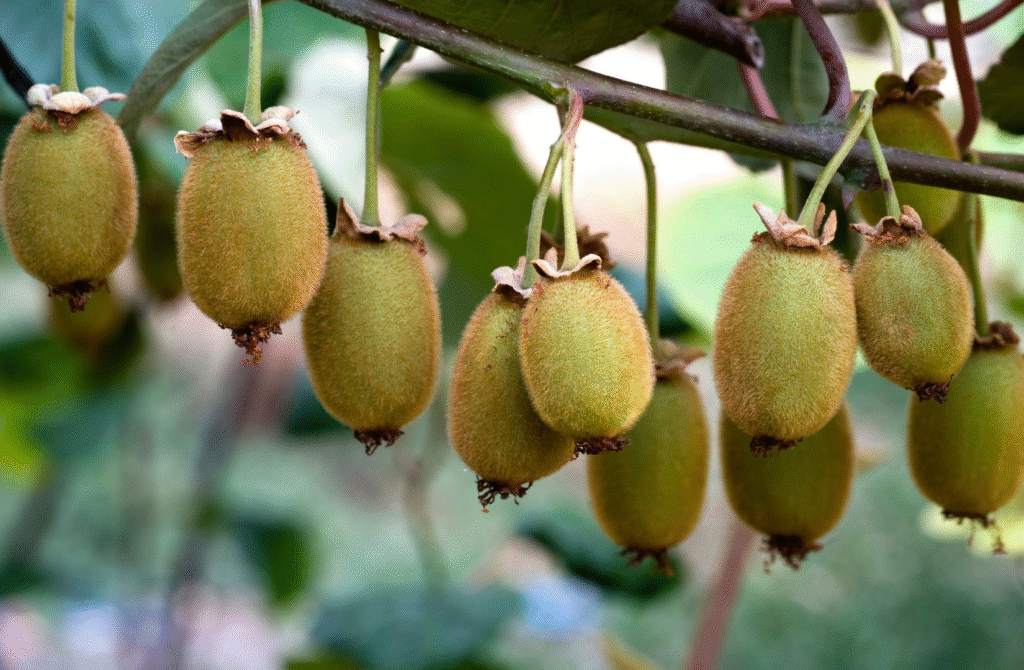
Common Pests and Diseases
Being aware of potential problems will help you maintain healthy kiwi plants:
Pest Management
Monitor regularly for these common kiwi pests:
- Japanese beetles: Handpick or use neem oil sprays
- Leafrollers: Remove affected leaves and use Bacillus thuringiensis when needed
- Root-knot nematodes: Practice crop rotation and use marigold companion plants
- Spider mites: Increase humidity and apply insecticidal soap when necessary
Disease Prevention
Common kiwi diseases and their management:
- Root rot: Ensure proper drainage and avoid overwatering
- Botrytis blight: Improve air circulation through proper pruning
- Phytophthora crown rot: Plant in well-draining soil and avoid crown injury
- Bacterial blight: Remove infected parts and avoid overhead watering

Harvesting and Enjoying Your Kiwi
After all your hard work, harvesting and using your homegrown kiwi is the ultimate reward.
When and How to Harvest
For optimal flavor and storage potential:
- Fuzzy kiwi: Harvest when fruits are firm but yield slightly to pressure
- Hardy kiwi: Pick when fruits change from green to brown or when a few begin to soften
- Testing for ripeness: Cut open a sample fruit to check for developed black seeds and proper color
- Harvesting technique: Cut (don’t pull) fruits with a small portion of stem attached
Storage and Ripening
Maximize the enjoyment of your harvest:
- Immediate enjoyment: Leave fruits at room temperature to ripen for 3-5 days
- Extended storage: Refrigerate firm fruits for up to 6 weeks
- Long-term storage: Keep in cold storage at 32-35°F with 90-95% humidity for up to 4 months
- Ripening acceleration: Place in a paper bag with an apple or banana to speed ripening
Conclusion
Growing kiwi plants can be a rewarding addition to your gardening repertoire. Whether you’re cultivating them in your garden, in containers on your patio, or even starting them from seeds, these versatile plants offer both ornamental value and delicious harvests. With proper care and patience, you’ll be enjoying homegrown kiwi fruits for years to come.
Remember that while kiwi plants require some specific attention, particularly regarding support structures and pruning, they’re relatively adaptable and can thrive in many parts of the US. By understanding the needs of these fascinating plants and following the guidelines in this article, you’ll be well on your way to kiwi-growing success.
For more detailed information on specific kiwi varieties suitable for your region, consult your local extension office or visit the USDA Plants Database for region-specific growing recommendations.
